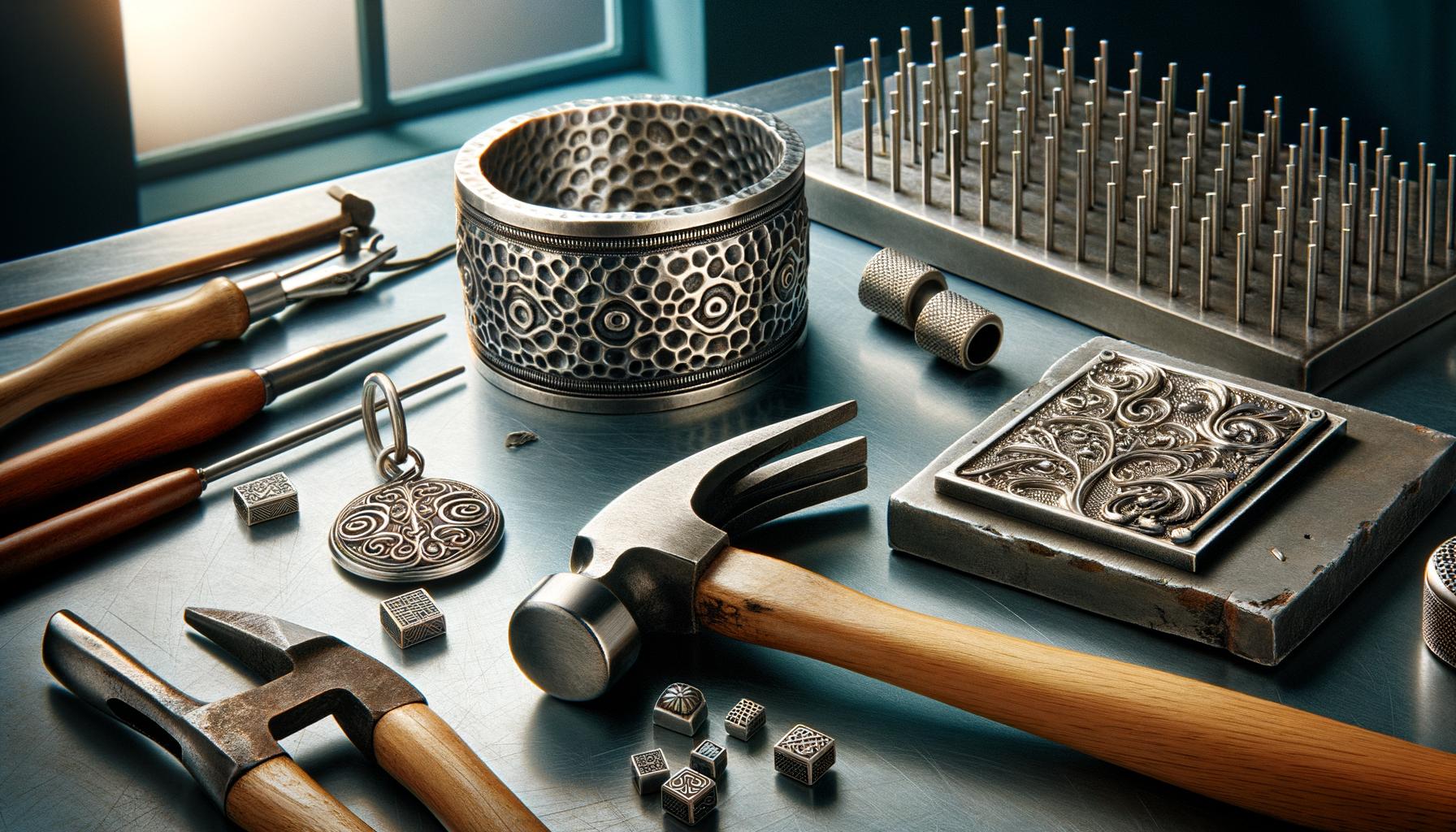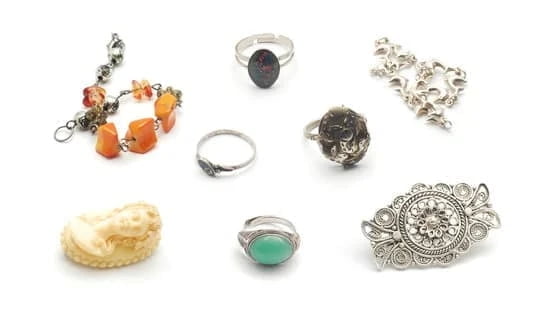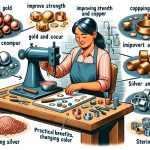Texture plays a pivotal role in jewelry design, offering artisans not just a canvas but an intricate landscape to craft unique, captivating pieces. The role of texture in jewelry design: hammering and embossing cannot be overstated; marred with history and artistry, these techniques add depth, flair, and character to each creation. This interplay of tactile surfaces offers a sensory experience that extends beyond the visual appeal of traditional jewelry, transforming each piece into a nuanced work of art.
Hammering and embossing are two renowned techniques within the realm of textured jewelry design. Hammering involves striking metal to create patterns, dimpled surfaces, or intricate impressions that vary based on the force and type of hammer used. This method has historical roots extending back centuries, illustrating both primitive functionality and sophisticated craftsmanship through metallic adornment. In contrast, embossing comprises pressing or stamping designs onto metal surfaces at varying depths, resulting in elegant raised patterns that enhance aesthetic allure.
These textural approaches amplify the artistry embedded in each jewelry piece by highlighting its uniqueness and story. They allow designers to push boundaries creatively-each strike of the hammer or press of an emboss adds narrative depth, evoking emotion and individuality in ways polished metals seldom achieve alone. By mastering these skills, jewelers can ensure their work stands out in a marketplace saturated with mass-produced items-a testament to creativity boundless as the medium itself.
The Significance of Texture in Jewelry Design
Texture serves as a fundamental element in jewelry design, giving each piece its unique personality and flair. It can vastly impact the perception and feel of a piece, turning something simple into a masterpiece that captures both the eye and the imagination. Texture creates depth, highlighting intricate details or emphasizing a sleek modern look, thereby making the role of texture in jewelry design: hammering and embossing, particularly invaluable.
Various textures can be incorporated into jewelry to achieve different aesthetics. A hammered texture can lend an organic and rustic charm to rings or bracelets. This technique not only adds visual interest but also tactile appeal, inviting wearers to touch and examine the surface more closely. On the other hand, smooth polished textures bring forth elegance and sophistication, often seen in high-end luxury pieces like engagement rings and necklaces.
Some popular textures include:
- Matte Finish: Provides a muted, non-reflective surface for a subtle yet refined look.
- Hammered Finish: Features small indentations created by striking the metal with varying degrees of force.
- Brushed Texture: Achieved through brushing the metal with abrasive materials for a streaky appearance.
- Embossed Patterns: Involve pressing designs onto metals to create raised patterns.
These various types contribute significantly to the overall design aesthetic of jewelry pieces. Hammered finishes provide an artisanal quality that feels timelessly chic while embossed patterns can exhibit detailed craftsmanship reminiscent of historical influences. By integrating these textural elements through techniques such as hammering and embossing, designers can produce works that are both visually stunning and imbued with character.
Understanding Hammering in Jewelry Making
Definition and Basic Principles of Hammering
Hammering is one of the oldest and most fundamental techniques employed in jewelry making. At its core, hammering involves striking metal surfaces with a specialized tool to create various textures and patterns. The metal can be worked on when it is cold or heated, depending on the desired effect.
This method manipulates the surface without necessarily altering its inherent structure. The impact force reshapes the metal in controlled ways, resulting in unique textures that add character and depth to each piece.
Historical Context and Evolution of the Hammering Technique in Jewelry
The use of hammering can be traced back to ancient civilizations where jewelers perfected this craft over millennia. Historically, artisans utilized basic stone or wooden hammers to achieve their desired effects before transitioning to more precise iron tools. Cultures such as the Egyptians, Greeks, and Romans developed distinctive hammered jewelry styles that have echoed through time into contemporary designs. The knowledge passed down through generations has been refined to adapt to modern aesthetics while preserving traditional expertise.
Tools and Materials Needed for Effective Hammering
The practice of hammering requires specific tools tailored for precision and variation in texture creation. Hammers come in various shapes and sizes, each serving a different purpose: ball-peen hammers are excellent for creating small indentations, while chasing hammers are ideal for fine detail work.
Texturing hammers feature etched heads designed specifically for imparting intricate patterns onto metal surfaces. Equally important are the materials-the choice between metals like gold, silver, copper, or brass significantly influences the final texture outcome due to each material’s malleability.
For aspiring jewelers looking to incorporate the role of texture in jewelry design: hammering and embossing are indispensable techniques that offer vast creative possibilities. In particular, mastering the art of hammering will provide a foundation upon which they can build more complex textural designs.
The Process of Hammering
Achieving Various Textures Through Hammering
Hammering is a versatile technique that can produce a wide range of textures, depending on the hammer’s shape, size, and the force applied. To start, one must select a suitable metal sheet or wire and secure it on a sturdy surface, like an anvil or steel block.
The process begins with light taps to create subtle dimples and progresses to more vigorous strikes for deeper impressions. By adjusting the hammer’s angle and the striking force, jewelers can achieve anything from delicate pebbling to bold, crater-like textures, each contributing uniquely to the finished piece.
Choosing the Right Hammers
Different types of hammers serve different purposes in jewelry design. Ball-peen hammers are ideal for generating rounded indentations, while cross-peen hammers create linear textures perfect for simulating woven fabric or flowing water patterns. Planishing hammers smooth out rough surfaces and refine previously hammered textures. Each hammer’s specific characteristics allow jewelers to experiment creatively with texture. For example, texturing punches can be employed alongside traditional hammers to imprint intricate designs that stand out against smoother backgrounds.
Showcasing Finished Pieces
The role of texture in jewelry design: hammering and embossing across various metals shows spectacular results through continuous experimentation. A hammered copper pendant may exhibit rustic charm with its uneven dimples catching light at different angles. Conversely, a silver bracelet adorned with meticulously planned ball-peen strikes might showcase elegance and sophistication by reflecting intricate wave-like patterns. These pieces not only boast tactile appeal but also demonstrate how diverse techniques enrich visual aesthetics in the realm of jewelry design.
Understanding how different hammering techniques yield varied textures unlocks endless opportunities for goldsmiths and hobbyists alike to craft distinctive designs that resonate both visually and emotionally with their audiences.
Introduction to Embossing in Jewelry Design
Embossing is a time-honored technique that imparts intricate, raised patterns on various surfaces, creating a unique and elegant texture. This method involves the deformation of material under pressure, resulting in raised designs that stand out from the background.
Unlike engraving or etching, which remove material to create a pattern, embossing adds dimension and emphasis without compromising the metal’s structural integrity. The role of texture in jewelry design: hammering and embossing are pivotal for achieving distinctive aesthetics that set pieces apart from conventional styles.
Historically, embossing has enjoyed a storied past, tracing its origins back to ancient civilizations where artisans used rudimentary tools to decorate metals and leather goods. Over centuries, the technique evolved significantly with advancements in metallurgy and tool making.
Modern-day embossing owes much to these ancient methods but now benefits from precision tools and innovative materials that allow jewelers to execute their visions with greater accuracy and detail. Today’s artists wield an array of stamps, dies, and molds fashioned from hardened steel to manipulate soft metals like gold, silver, and copper into elaborate designs.
For those looking to master this decorative art form, it is essential to familiarize oneself with several key tools and materials required for effective embossing. Basic items include a selection of metal sheets or blank forms-the canvas upon which you’ll work your magic-and an assortment of embossing tools designed for detailed craftsmanship:
- Metal Sheets: Choose softer metals such as copper or silver for easier manipulation.
- Embossing Stamps: Pre-made stamps come in various designs suitable for repetitive motifs.
- Repoussé Tools: For freehand designs requiring more nuanced control over texturing.
The evolution of these essential tools speaks volumes about how far embossing has come since its early days. With modern equipment complementing traditional methods, jewelers can now create even more intricate patterns that contribute richly textured elements to their works. By understanding both the historical context and practical necessities of the craft, aspiring jewelers can appreciate the profound impact embossing has had-and continues to have-on evolving jewelry design trends.
The Embossing Process
Embossing in jewelry design involves creating raised or recessed designs on a metal surface, resulting in intricate textures and patterns that add artistic flair to the piece. This method requires precision and craftsmanship, beginning with a well-thought-out design. Artisans often start by sketching the intended pattern, which helps in visualizing the final outcome before any metalwork begins.
The first step in embossing is preparing the metal surface, usually by cleaning and annealing it to make it more malleable. Once prepped, jewelers use specialized tools such as embossing punches or styluses to impress the design onto the metal. The role of texture in jewelry design: hammering and embossing becomes evident here as each indent made by these tools adds depth and complexity to the piece, turning it into a tactile work of art.
To ensure flawless execution, artisans must continuously check their progress against the original sketch. This vigilance minimizes errors and ensures uniformity across complex patterns. Sometimes, multiple passes are required with various tools to achieve detailed textures. For example, a jeweler might use one punch for broad strokes and finer-tipped instruments for intricate details. Applying different pressures can also vary the texture’s prominence on the jewelry piece.
| Embossing Tool | Usage |
|---|---|
| Punch | Creating broad strokes or general shapes |
| Stylus | Adding fine details and intricate lines |
Once completed, embossed designs may proceed through finishing steps such as polishing or patinating to enhance their visual impact further. Polishing brings out contrasts between raised areas and recesses, while patination can add color variations that highlight different aspects of the textured pattern. Through meticulous execution of these methods, embossers transform simple metal sheets into compelling jewelry pieces characterized by their unique textures and elaborate designs.
Comparing Hammering and Embossing
When delving into the world of jewelry design, understanding the unique strengths and qualities of hammering and embossing techniques is vital. Hammering, known for its ability to create organic, tactile surfaces through repetitive impact, offers a raw and rustic charm.
Each strike creates a distinctive pattern that can vary in depth and width, depending on the force used and the shape of the hammerhead. This technique allows artisans to impart a sense of movement and fluidity to their creations, enhancing their visual appeal.
In contrast, embossing provides a method of adding raised designs to metal surfaces, often resulting in more intricate and detailed patterns. Utilizing tools like stamps or dies, embossing allows for precision in reproducing complex motifs.
This makes it an ideal choice for creating ornate designs with both visual and tactile richness. The role of texture in jewelry design: hammering and embossing becomes particularly evident when comparing pieces side by side: where hammering presents a more rugged finish echoing natural forms, embossing delivers an almost ethereal elegance with its finely crafted details.
The decision to use one technique over the other-and sometimes both in tandem-depends largely on the desired effect and functional requirements of the piece. Hammered textures work exceptionally well for those seeking an earthy, artisanal feel that celebrates imperfections as part of its aesthetic appeal.
Embossed textures are preferred when aiming for sophistication and detail-oriented artistry that captivates through precision. Several renowned designers have successfully combined these methods to create masterpieces that leverage the best attributes of each approach.
| Technique | Strengths |
|---|---|
| Hammering | Organic texture, rugged charm |
| Embossing | Intricate details, precise motifs |
Incorporating Texture Into Modern Jewelry Design
The landscape of modern jewelry design has seen a significant shift toward incorporating more intricate textures, elevating the aesthetic value and tactile experience of each piece. Designers today are increasingly experimenting with the role of texture in jewelry design: hammering and embossing. These two fundamental techniques have found new life as artists push the boundaries of traditional methods, infusing their work with both contemporary flair and timeless appeal.
One emerging trend is the blend of mixed metals to create juxtaposed textures within a single piece. For example, a bracelet might feature a hammered gold band alongside an embossed silver section, each texture highlighting the distinct qualities of the metal used.
Hammering produces an appealingly rough surface that scatters light in uneven patterns, creating an engaging play on shine and shadow. Meanwhile, embossing can render meticulous designs such as floral motifs or geometric shapes that offer depth and an intricate beauty to the overall composition.
The role of technology cannot be understated in this evolution. Advanced software and precision tools enable designers to experiment with textures at microscopic levels, achieving intricacies once deemed impossible by hand alone.
3D printing technology has also made it feasible to prototype textured pieces swiftly, providing a tangible sense of how different textures interact within a design before committing to final production. This melding of tradition and innovation ensures that texture remains vital in modern jewelry craft, continuously offering fresh possibilities for artisans worldwide.
Care and Maintenance of Textured Jewelry
Caring for textured jewelry, especially pieces that have been crafted using hammering and embossing techniques, requires a bit more attention than smooth-surfaced jewelry. The role of texture in jewelry design: hammering and embossing introduces unique challenges in maintenance due to the nature of their intricate surfaces. Proper care ensures that these detailed designs remain vivid and the jewelry retains its charm over time.
One primary tip for preserving the texture and appearance of hammered and embossed jewelry is regular cleaning. Given that textures can trap dirt and oils more readily than flat surfaces, it’s important to use appropriate cleaning methods. For instance, using a soft toothbrush with mild soap can effectively remove grime from the nooks and crannies without causing damage. Avoid abrasive cleaners or rough cloths that could wear down the intricate details of the texture.
Storage also plays a crucial role in maintaining textured jewelry’s beauty. To protect these elaborate surfaces from scratches or other damage, it is best to store each piece separately. Using individual pouches or compartments within a jewelry box can prevent items from rubbing against one another.
Moreover, ensuring they are kept in a dry environment will prevent tarnishing, especially for silver pieces which are prone to oxidation. These measures help keep textured surfaces looking their best and extend the life of your treasured pieces.
Conclusion
As we have seen throughout the article, texture plays an invaluable role in elevating the artistry and uniqueness of jewelry design. Techniques such as hammering and embossing not only add depth and character to pieces but also offer jewelers an expansive creative outlet.
Both methods bring their own distinct strengths to the table: where hammering can impart a rustic, tactile quality, embossing allows for intricate patterns that stand out with elegance and precision. Understanding the role of texture in jewelry design: hammering and embossing, allows jewelers to craft pieces that are both visually captivating and rich with personal expression.
For aspiring jewelers looking to push the boundaries of their craft, experimenting with these techniques is immensely rewarding. Hammering offers a hands-on approach to shaping metals, building a deep connection between the designer and materials. Embossing, on the other hand, invites meticulous attention to detail, lending itself to creating elaborate designs that captivate the eye. The fusion of these techniques can lead to innovative designs that appeal across diverse tastes, ensuring each piece remains individualistic and engaging.
Looking ahead, textured jewelry is destined to retain its timeless appeal while continuing to evolve through modern trends and technological advancements. New tools and materials offer unprecedented opportunities for creativity, allowing designers to perfect traditional methods while introducing contemporary innovations.
Whether preserving cherished hammered or embossed pieces through proper care or delving into new projects inspired by these classic techniques, jewelers have a promising future ahead in the world of textured jewelry design. The allure of texture will never fade from fashion as it consistently breathes new life into every unique creation.
Frequently Asked Questions
What Is a Textured Hammer Used For?
A textured hammer is a specialized tool in metalworking and jewelry making that is used to create unique patterns, designs, and surface textures on metal pieces. By striking the metal with the different faces of the hammer, artisans can achieve various textures such as dimples, grooves, or swirls.
This not only enhances the visual appeal of the item but also adds tactile interest. Textured hammers help craftspeople add intricate details to their work without needing complex machinery or equipment.
What Is Texture in Jewelry?
In jewelry, texture refers to the tactile quality and visual pattern present on the surface of a piece. Texture can be smooth, rough, matte, shiny, grooved, hammered, or etched—essentially any treatment that changes both how a piece looks and feels when touched.
Artisans often apply texture to jewelry to create depth and interest in their designs, allowing them to stand out and convey a particular aesthetic or theme. It plays an essential role in enhancing the individuality and uniqueness of each handcrafted piece.
Is a Technique in Which Artists Use Tools to Hammer Texture Into a Metal Surface?
The technique in which artists use tools to hammer texture into a metal surface is known as texturing or hammering. This process involves using various types of hammers with differently shaped heads or specially-crafted texturing tools to imprint patterns onto the metal’s surface through repeated strikes.
These imprints can range from subtle indentations to more pronounced decorative motifs depending on the force applied and the specific tool used. By manipulating how light interacts with these textured surfaces, artists can significantly alter the appearance and character of their metalwork creations.

Welcome to my jewelry blog! My name is Sarah and I am the owner of this blog.
I love making jewelry and sharing my creations with others.
So whether you’re someone who loves wearing jewelry yourself or simply enjoys learning about it, be sure to check out my blog for insightful posts on everything related to this exciting topic!





